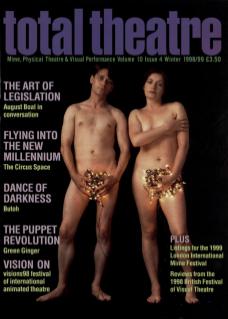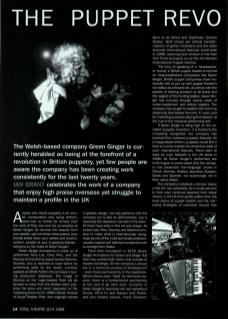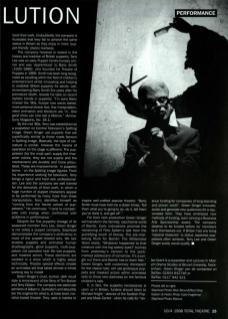Anyone who thinks puppetry is an insular, conservative and dying artform, need look no further for remedy than the work of Terry Lee and his co-creators at Green Ginger. So remove the swazzle from your poodle, spit out those chess pieces, pour brandy butter down your wellies and scratch, scratch, scratch at your in-growing follicles – welcome to the world of Green Ginger!
Green Ginger Animations is made up of performers Terry Lee, Chris Pirie, and Dik Downey and technical wizard James Osborne. Downey, who is reported to have learnt his performing skills on the street, currently appears as Dibdin Todd in the company's touring production Slaphead. The image of Downey as the huge-headed Todd will be familiar to many from the photos which publicise the show and which appeared on the marketing brochure for 1998's British Festival of Visual Theatre. Pirie, who originally trained in graphic design, not only performs with the company but is also its administrator. Lee is reputedly the obsessive member of the team. All three have skills in fine art and design. As a team Lee, Pine, Downey and Osborne combine to make what is internationally recognised as one of the most technically proficient, visually inspired and talented companies ever to emerge from Wales.
From their conception in 1978, Green Ginger Animations for Street and Stage (full title) has worked both within and outside of theatre buildings. All the company's shows are in a continual process of development – even those permanently in the repertoire. Where shows seem 'fixed' for technical reasons, there is a fundamental spontaneity at the root of all their work. Currently in Green Ginger's repertoire are two walkabout shows, P.R.A.T.s and Gaston and Pedro, and two theatre pieces, Frank Einstein: Born to be Wired and Slaphead: Demon Barber. Both shows are radical transformations of gothic Victoriana and the latter stormed international festivals worldwide in 1998, receiving rave reviews in the New York Times during its run at the Jim Henson International Puppet Festival.
The irony of speaking of a 'renaissance’ or 'revival' in British puppet theatre is not lost on long-established companies like Green Ginger. British puppet companies have historically had to put up with puppet theatre's low status as a theatre art, as well as with the poverty of training provision at all levels and the neglect of the funding bodies. Green Ginger has survived through twenty years of under-investment and critical neglect. The company has sought to weather the storm by distancing themselves from the 'P' word, and for marketing purposes placing themselves 'at the hub of the miniature performing arts’.
If Green Ginger is riding high on the so-called 'puppetry revolution’, it is thanks to the increasing recognition the company has received from overseas puppetry festivals. As a marginalised artform, puppetry would find it hard to survive outside the protective walls of such international festivals. There were at least six such festivals in the UK alone in 1998. All Green Ginger's performers are multi-lingual to some extent and the company has presented 'low-language' shows in French, German, Hebrew, Japanese, Russian, Greek and Spanish, but surprisingly not in their native Welsh.
The company's relatively unknown status in the UK may, perversely, be in small part due to their near continual absence from these shores. In the UK their profile suffers from the lowly status of puppet theatre and the marketing strategies of individual venues that book their work. Undoubtedly, the company is frustrated that they fail to achieve the same status in Britain as they enjoy in more 'puppet-friendly’ places overseas.
The company however is rooted in the history and tradition of British puppetry. Terry Lee was an early Puppet Centre bursary winner and was 'apprenticed' to Barry Smith (1930-1989), who founded his Theatre of Puppets in 1969. Smith has been long recognised as excelling within the field of children's entertainment whilst innovating and helping to establish British puppetry for adults. Lee, remembering Barry Smith five years after his premature death, reveals his take on recent stylistic trends in puppetry: ‘I'm sorry Barry missed the 90s. Europe now wants darker, more personal shows: text, fine manipulation, video animation and literature are “in”. One good show can now last a lifetime.’ (Animations Magazine, No. 18.1)
By the mid 80s, Terry was established as a puppeteer on Central Television's Spitting Image. Green Ginger use puppets that are superficially similar to those made famous in Spitting Image. Basically, the style of caricature is similar, however the means of operation on the stage is different. The puppeteers (for the most part) supply the character voices, they are not supine and the mechanisms are durable and more articulated. These are improvements – in puppetry terms – on the Spitting Image figures. From his experience working for television, Terry brings a rigour and hard won professionalism. Lee and the company are well trained for the demands of their work, in which a huge number of puppet characters appear to be performed by many more than three manipulators. Terry identifies himself as ‘coming from the frantic school of puppeteers’. He continues: ‘I tend to compensate with energy when confronted with problems in performance.’
Despite the fine puppetry lineage of its seasoned member Terry Lee, Green Ginger is not solely a puppet company. Slaphead demonstrates the company's proficiency in most of the puppet-related arts. We see shadow puppets and animated human shadowgraphs, glove puppetry, multi-puppeteer rod-operated near life-size puppets, and masked actors. These elements are wedded in a show which is highly adept technically. Theatre special effects inhabit an animated set that takes almost a whole working day to install.
Green Ginger's cruel, surreal, dark visual style is reminiscent of the films of Tim Burton and Terry Gilliam. The company are particular admirers of Gilliam. Surrealism and absurdity are the engines for what is, at base level, narrative-based theatre. Terry uses a mantra to inspire well-crafted popular theatre: ‘Barry Smith must have told me a dozen times, “Tell them what you're going to do, do it, tell them you've done it, and get off”.’
For their next production Green Ginger will transform the familiar, saccharine world of Bambi. Early indications promise the reclaiming of Felix Salten's tale from the putrefying touch of Disney. The pre-marketing blurb for Bambi: The Wilderness Years reads: ‘Whatever happened to that creature with the big watery eyes? Journey from yesterday's cartoon to the pockmarked adolescent of tomorrow. It's a jungle out there and Bambi has to learn fast.’ Green Ginger, with customary disrespect for the classic tale, will use grotesque puppets and masked actors within animated sets to throw new darkness on the famous children's tale.
If, in fact, the puppetry renaissance is upon us in Britain, funders should listen to Michael Knight – director of the Scottish Puppet and Mask Centre – when he calls for ‘revenue funding for companies of long-standing and proven worth’. Green Ginger innovate, excite and generate new audiences for a rejuvenated form. They have embraced new methods of funding, even winning a Business Arts Sponsorship award. The company deserve to be funded before its members burn themselves out. If Britain had any living 'national treasures’ (a status Japanese puppeteers often achieve), Terry Lee and Green Ginger surely would qualify.
Ian Grant is a puppeteer and Lecturer in Modem Drama Studies at Brunel University, Twickenham.


